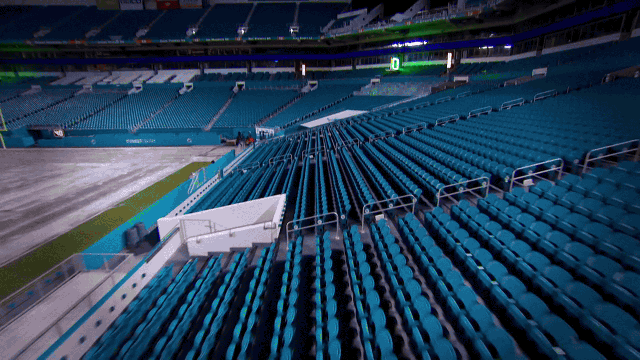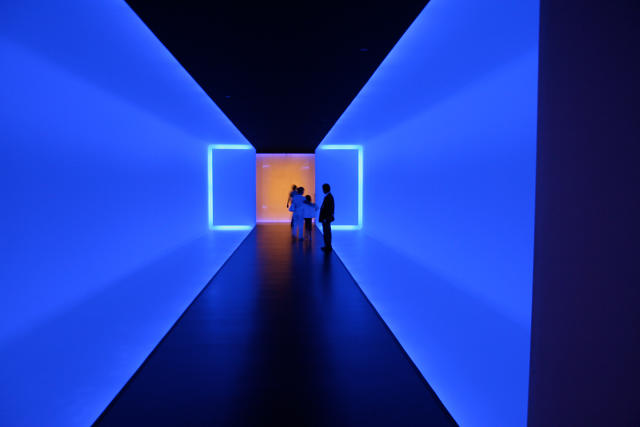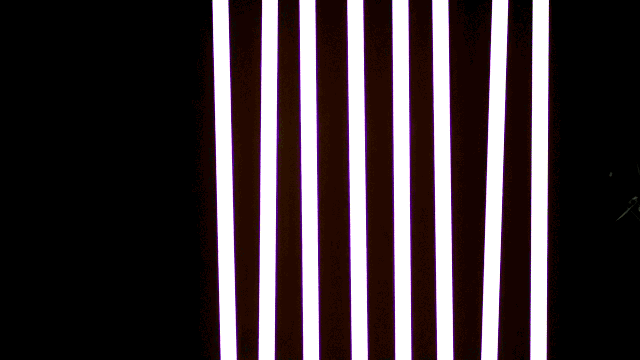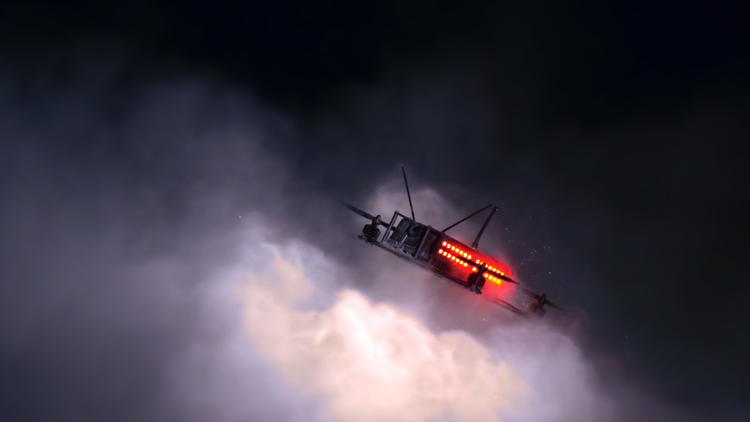If you ever want to see really impressive filmmaking, don’t load anything on the AFI top 100 list. Tune into football on any given Sunday. A game is a 3.5-hour event, but it only includes 11 minutes of action. The average play just lasts four seconds. The rest—the replays, the slow mos, the graphics, the cheerleaders—is all ganache. The NFL is more art than sport.
Which is why when L.A. creative studio Culprit Creative was approached by Drone Racing League (DRL) to figure out how to turn the experience of a few hobbyists racing drones in a field into a full-blown, broadcast-level sport, creatives turned to the world of the arts rather than sports. “We could have had a checkered flag and a start line,” says DRL founder and CEO Nick Horbaczewski. “This could look and feel like Tron, or like a Nascar race. Making all of those decisions is tough. Design is essential if you’re trying to film a new sport like this.”
Horbaczewski, the former chief revenue officer for Tough Mudder, founded DRL in 2015 in hopes of finding the next big sports phenomenon. In less than a year, he raised $8 million in funding, and has already shot two DRL events—one of which took over the stadium of the Miami Dolphins (their owner is an investor).

In DRL races, carbon fiber drones fly at speeds up to 90 mph, while pilots see a first-person view through video headsets. Horbaczewski likens the race as existing at the halfway intersection of video games and Star Wars. But before he found the right partners to build out the DRL aesthetic, that concept was mostly seen only in his mind. In reality, these drones are just 10 inches long. They weigh a mere 1.8 pounds. Picture a sparrow flying over a Dolphins game. Would you even notice the thing?
Answering a bid for the project, the Culprit team spotted the potential immediately. With a team that had experience shooting extreme sports—creating some of Red Bull’s early viral content—as well as building campaigns for video games, they had a strangely perfect resume to tackle the drone racing aesthetic.
Rule one was that whatever DRL was, it had to “look cool,” says Culprit’s David Dinetz. “You see things like Battlebots on TV, and it’s such a lame interpretation of what robots and machines should look like. That’s not what I see in my mind.”
“There will be no future of underground robots battling each other,” adds cinematographer Colt Seman with a laugh.

Instead, Culprit imagined DRL as moving through art in 3-D space. And so they looked to installation artists they admired—the neon tubes of Dan Flavin and the transcendent glow of James Turrell rooms—and considered how they could apply these aesthetics to a one-kilometer track that might include open expanses and claustrophobic hallways. One answer was that drones were fit with 100 LEDs to be visible in the air. They also visited Kino Flo—the lighting company that produces the bread-and-butter light of Hollywood productions, a very low-heat, soft fluorescent tube that can be stuck almost anywhere. Culprit bought literally every green and red tube the company had available in North America to light turns and construct giant 20-foot-by-20-foot rings for the drones to fly through like checkpoints.

There was one last visual element the team knew they had to nail to create their drone art vision. “Blowing something up is art in an instant,” says Culprit’s Dylan Trussell, alluding to the high-speed photography of MIT scientist and flash strobe pioneer Harold Edgerton.
“Imagine a drone crashing through color fluorescent lights at over 1,000 miles an hour in an explosion of light, dust, smoke, and debris,” Trussell says, recounting how he sold DRL on his studio’s idea. “That’s what we set out to capture.” And they did, in this shot filmed in a promotional video for the league.

Staged shots like this one aren’t all that difficult for a production company to film under studio settings. But scaling the aesthetic and shooting it in a real series of races was far more difficult. The Culprit team used cinema lenses and cameras—rather than the mega-zoom broadcast cameras used by pro sports—to create a very shallow depth of field. This meant that just the drones would be in focus in tight shots, and a background blur of shadow and light would offer a larger than life sense of speed.
“We had to learn how to film these drones,” Seman says. “At Red Bull, we always had to create a style or look depending on what we’re shooting. [For the drones], we had to practice with Red cameras and zoom lenses, so we could find the perfect balance. Trying to follow and film on a regular camera is impossible.”
They also worked closely with engineers at DRL to design courses with dramatic moments—like tight spaces where a drone would suddenly have to change directions—and awaited the “1,000-mph” carnage with high-speed cameras standing at the ready.
Thus far, DRL has operated with the advantage of shooting a live event, but not filming a live broadcast. This has allowed the Culprit team to insert some of these dramatic moments into videos tens of millions of people have watched YouTube-style, well after the event ended.
Horbaczewski admits that he doesn’t know the perfect venue for DRL races. Only a few hundred people attend the live events, as it’s not really possible to build out, easily at least, as a spectator sport. It translates superbly to video, but can the sport grow on a time delay? Or does it need to be a live broadcast—to be something more like Twitch or television itself.
For now, a competing drone event league—the International Drone Racing Association—has already signed a multiyear deal that begins with ESPN this summer. Looking at the previewed visual style, there’s no comparison: ESPN will depict a maker-culture event, with drones racing through grassy outdoor fields in search of the traditional checkered flag. It’s exactly what Horbaczewski didn’t want: smiling geeks driving R/C planes, with occasional first-person views.
But just a few races into their own league, Horbaczewski and Culprit have already made the high art concession to use the big-zoom broadcast cameras deployed everywhere from the MLB to the NFL to accomodate big venues, and only more tweaks will come if DRL wants to produce a faster product in which fans could experience more minutes of footage, and maybe even, one day, a live event. Meanwhile, Culprit is stepping back on the project to shoot their first feature film, handing over the aesthetic they created to be produced by DRL in-house with the help of experienced sports camera operators.
“People are used to things like Formula One that have decades of design work put into them,” says Horbaczewski. “We’re trying, from scratch, to get to that level as fast as possible.”
All images (unless otherwise noted): via Drone Racing League


(41)